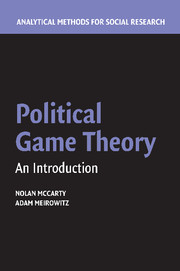Book contents
- Frontmatter
- Contents
- Acknowledgments
- 1 Introduction
- 2 The Theory of Choice
- 3 Choice Under Uncertainty
- 4 Social Choice Theory
- 5 Games in the Normal Form
- 6 Bayesian Games in the Normal Form
- 7 Extensive Form Games
- 8 Dynamic Games of Incomplete Information
- 9 Repeated Games
- 10 Bargaining Theory
- 11 Mechanism Design and Agency Theory
- 12 Mathematical Appendix
- Bibliography
- Index
5 - Games in the Normal Form
Published online by Cambridge University Press: 05 June 2012
- Frontmatter
- Contents
- Acknowledgments
- 1 Introduction
- 2 The Theory of Choice
- 3 Choice Under Uncertainty
- 4 Social Choice Theory
- 5 Games in the Normal Form
- 6 Bayesian Games in the Normal Form
- 7 Extensive Form Games
- 8 Dynamic Games of Incomplete Information
- 9 Repeated Games
- 10 Bargaining Theory
- 11 Mechanism Design and Agency Theory
- 12 Mathematical Appendix
- Bibliography
- Index
Summary
At twelve and a half minutes into the broadcast, Detectives Logan and Briscoe arrest two murder suspects. District Attorney Adam Schiff instructs Assistant D.A. Jack McCoy to make the following offer to each separately:
If you confess and provide evidence of first-degree murder by your accomplice, you will receive a 1 year sentence on a weapons charge provided that your accomplice does not confess. If she does confess as well, you both will get 8 years for murder II.
If you hold out and your accomplice turns state's evidence, you will serve 25 to life for murder I. If she also holds out, you will serve 4 years for voluntary manslaughter.
Assuming each suspect loses one unit of utility for each year in prison, Table 5.1 shows the payoffs of each subject given all of the possible outcomes. The rows represent the actions of suspect 1 whereas the columns represent the actions of suspect 2. Each pair of numbers represents the payoffs for suspect 1 and suspect 2 for each combination, respectively.
The situation of the suspects is strategic because the outcome of any action by suspect 1 depends on the choices of suspect 2, and vice versa. What should the suspects do? Collectively, they prefer to hold out. If they both hold out, the total jail time is only eight years, far less than any other outcome. Unless, however, they reach a binding agreement, the individual incentives of the suspects undermine this outcome.
- Type
- Chapter
- Information
- Political Game TheoryAn Introduction, pp. 87 - 149Publisher: Cambridge University PressPrint publication year: 2007

